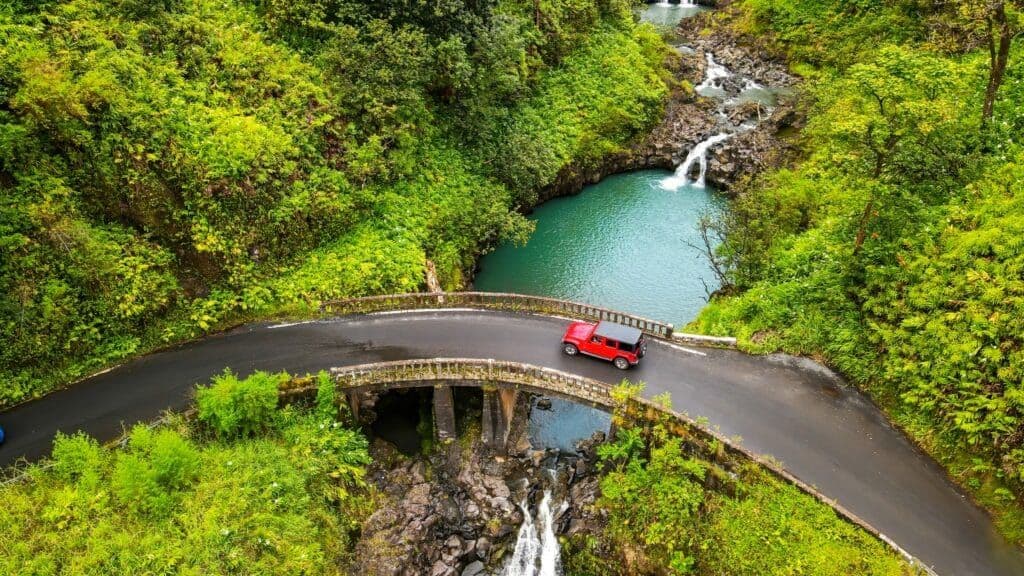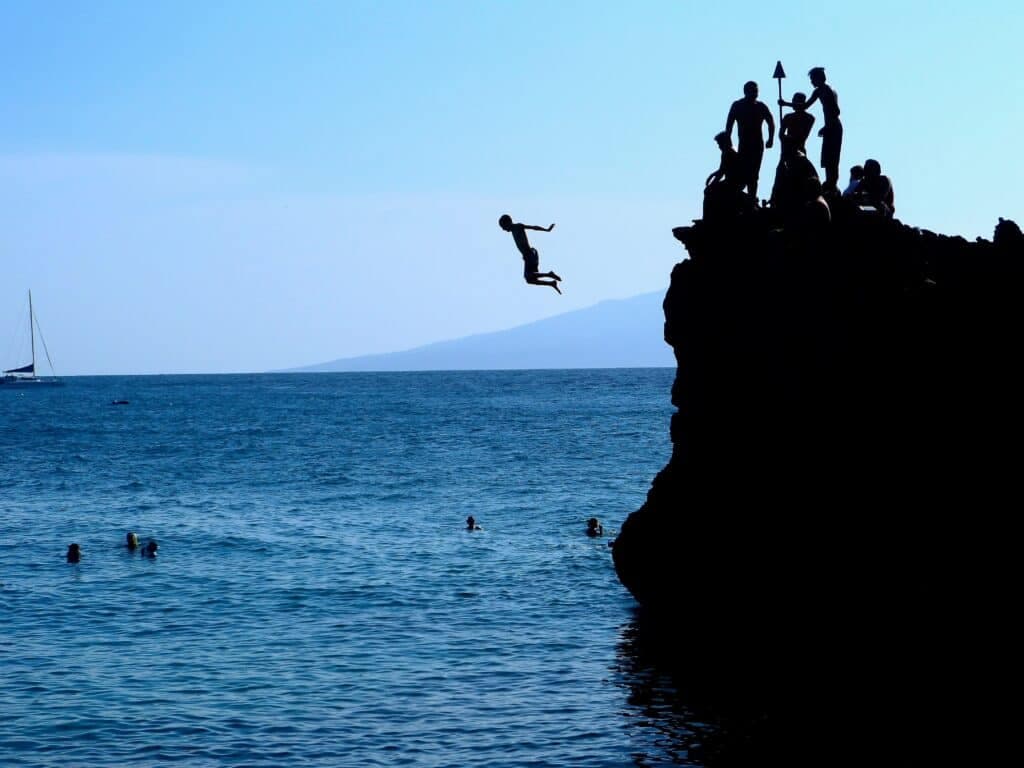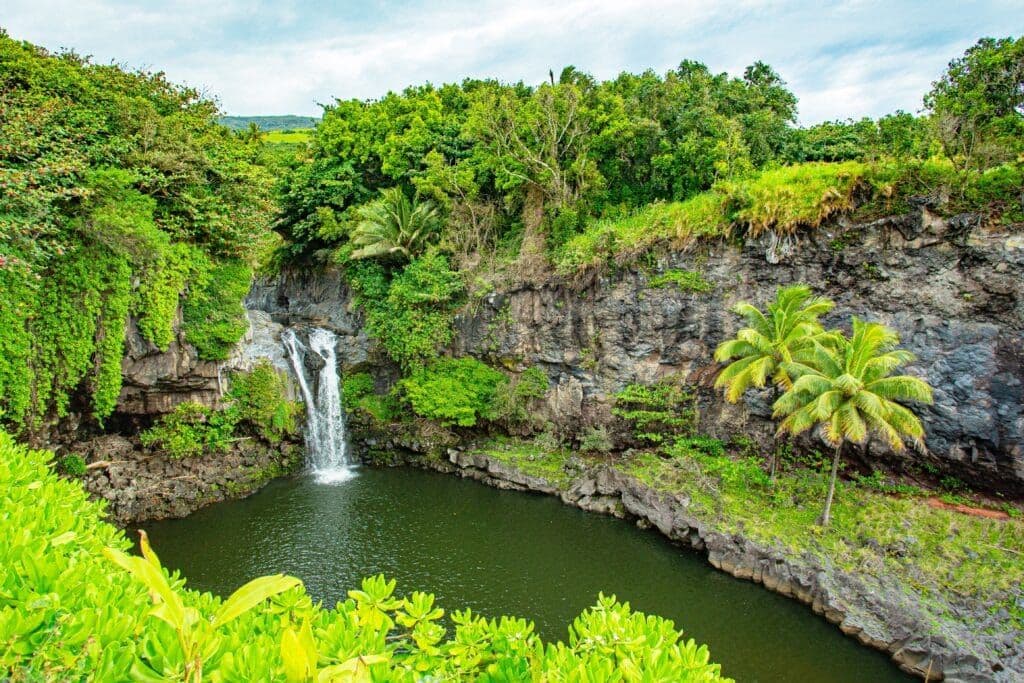By Stephanie Namahoe Launiu
Maui isn’t short on adventure — it’s overflowing with it. This stunning island delivers the full Hawai‘i experience: white and black sand beaches, a dormant volcano you can summit at sunrise, lush mountains begging to be explored, and turquoise waters that double as winter whale nurseries. Whether you’re hiking bamboo forests, snorkeling with sea turtles, or chasing waterfalls on the Road to Hāna, Maui’s natural wonders set the stage for an unforgettable escape. With a little planning, every day can be packed with beauty, thrills, and awe. Here are the top seven things to do in Maui for the ultimate adventure.

View from top of the Maui waterfalls, one of the famous bridges on the Road to Hana (Shutterstock)
Nicknamed Turtle Town, Mākena’s Maluaka Beach is one of the best places in Maui to spot green sea turtles. Just 200 yards offshore, a vibrant reef teems with life — parrotfish, octopuses, barracuda, and even manta rays glide through these waters. And yes, you’re almost guaranteed a turtle sighting.
For a more intimate and eco-friendly experience, skip the big boats. Join a guided kayak tour and paddle out. You’ll get closer to nature and earn those views.
Book a tour with Maui Kayak Adventures or Aloha Kayaks Maui
Launch from Makena Landing.
Paddle for 15–20 minutes to reach Turtle Town and snorkel with green sea turtles.
Morning tours have calmer water and better visibility.
Tours include all gear but pack reef-safe sunscreen and water shoes.
If you’re hungry afterward, there’s usually a food truck in the parking lot. But just a couple miles away is Monkeypod Kitchen and many more restaurants in Wailea.
Tucked in Central Maui, the Waiheʻe Ridge Trail is a must for hikers craving sweeping views and lush scenery. This 2.5-mile climb takes you through a misty Cook pine forest, past the tiered Makamaka‘ole Falls, and along the edge of the Waihe‘e Valley, with panoramic vistas of Haleakalā and the coastline below. Pack a picnic for unimpeded views of the valley.
Drive to the trailhead via Kahekili Hwy.
Hike 5 miles roundtrip through forest, ridges, and valley overlooks (elevation gain: 1500 ft.)
Enjoy the view.
Go early — the parking fills up by 9 a.m.
Expect mud and slick spots — trekking poles help.
Bring water, snacks, or a light lunch.
There are parts of the hike without shade. Plan accordingly with sunscreen and layers.

Cliff Jumping in Hawaii (Shutterstock)
One of Maui’s most legendary ali‘i (high chiefs), Kahekili ruled from around 1766 to 1793 and was revered for his mastery of lele kawa — cliff diving. According to oral history, he would hurl himself into the sea from heights as dizzying as 300 to 400 feet, earning both fear and admiration.
His most famous leap was from Pu‘u Keka‘a, now known as Black Rock in Kā‘anapali. Once believed to be a sacred pathway for spirits, while others hesitated, Kahekili’s daring dives cemented his status among the warriors and storytellers.
Every evening at sunset, a Sheraton Maui Resort & Spa diver gracefully leaps from the top of the rock into the ocean, symbolizing the great chief’s dives, as torches are lit for the night to honor the souls of the departed.
Pro Tip: For an early dinner after your jump, try the Cliff Dive Grill. You can stay for the nightly torch-lighting ceremony.
Go to Kaʻanapali Beach, head north to Pu‘u Kekaʻa (Black Rock).
Climb up the lava rock (there’s a worn path).
Jump from ~15 feet into clear water below.
Only jump when the water is calm.
Don’t dive — jumping feet-first is the safest.
Watch others do it before taking the plunge.

O’heo Gulch (Seven Sacred Pools), Maui, Hawaii (Shutterstock)
Tucked on the remote eastern tip of the island, Hāna is a quiet town of just 1,500 residents. It’s peaceful, secluded, and steeped in Hawaiian history. But here’s the secret: the magic isn’t just in reaching Hāna — it’s in the road that takes you there.
With over 600 curves and nearly 60 one-lane bridges, the Road to Hāna is an exhilarating 64-mile journey through lush rainforests, past hidden beaches, and towering waterfalls. It’s one of those rare places where the trip is the destination and one of Maui’s most well-known and sought-after attractions.
If you drove straight through, you’d reach Hāna in about 2.5 hours. But most travelers take their time, stopping to explore bamboo groves, swim under waterfalls, and snack on fresh banana bread from roadside stands. Our advice? Go slow, soak it in, and let the road lead you.
Start early from Paia around 7 a.m.
Plan your route and timing in advance. Recommended spots: Twin Falls, Garden of Eden, Wailua Overlook, Waiʻānapanapa Black Sand Beach, Pipiwai Trail.
Get a rental car with good handling (compact SUVs are great), or book a guided tour if winding, one-way roads aren’t your thing.
Download offline maps (the WIFI is weak or non-existent) or get the Guide Along App.
Pack food, water, cash, and motion sickness meds (it’s that winding).
If you’re looking for an unforgettable Maui adventure, Haleakalā National Park should be on your bucket list. Towering over 10,000 feet above sea level, this dormant volcano offers otherworldly landscapes, panoramic views of the West Maui Mountains, and the dramatic Koʻolau Gap — a dream for hikers, photographers, and nature lovers.
The park’s network of trails suits every skill level, from easy walks to challenging backcountry treks. For the full experience, camp overnight and stargaze beneath crystal-clear skies. And don’t miss the summit sunrise— it’s worth the early wake-up call.
Haleakalā is also home to rare species like the nēnē (Hawaiian goose) and the silversword plant, found nowhere else on Earth. Stop by the Visitor Center to learn about the park’s unique ecology.
Reservations are required for sunrise hikes only (departing 3 a.m. to 7 a.m.).
Admission: The cost is $1 per vehicle plus the park entry fee ($30 per car valid for three days)
Time it right: For sunrise: leave Kahului by 3:30 a.m., for sunset, arrive 45–60 minutes before the sun dips, midday hikes have the clearest views and the least traffic.
Dress warm: Temperatures drop to 30–40°F (or lower), before sunrise. Pack layers, a jacket, hat, gloves, or even a blanket
Know what to pack: Bring water and snacks (there’s no food at the summit), a headlamp or flashlight (for early or late visits), binoculars or stargazing apps if you’re staying late, and extra phone chargers or camera batteries — they drain faster in the cold.
For an unforgettable underwater adventure in Maui, snorkeling at Molokini Crater is a must. This crescent-shaped, partially submerged volcanic crater is a protected marine sanctuary, home to vibrant coral reefs and an explosion of tropical marine life.
Just a short boat ride from shore, Molokini offers some of the clearest waters in Hawai‘i, with visibility often exceeding 100 feet. Most tours include gear, guidance, and local legends. In these turquoise depths, you might spot Hawaiian parrotfish, Maui butterflyfish, and the occasional sea turtle gliding by. Because Molokini is ecologically fragile, all visitors are asked to follow preservation guidelines to help protect its thriving ecosystem.
Book a boat tour with Redline Rafting, Four Winds II, or Trilogy.
They’ll take you to Molokini + Turtle Town (snorkel) or Molokini Back Wall (SCUBA).
Choose early morning tours for calmer seas.
You need to be certified if you want to SCUBA. Check with your tour provider for beginner or discovery dive options.
Bring a GoPro or underwater camera.
Maui is renowned for its whale-watching opportunities, with humpback whales migrating to the island’s warm waters from December to May. A whale-watching excursion is a thrilling way to witness these majestic creatures up close and learn about their fascinating behaviors.
Guides like the Pacific Whale Foundation provide insightful commentary on the whales’ biology and behavior, enhancing your appreciation for these gentle giants. You’ll have the chance to see mothers and calves, as well as other marine life like sea turtles and tropical fish.
Go with a small boat operator like Redline Rafting or Ultimate Whale Watch (Lahaina).
For kayaking, try Hawaiian Paddle Sports — they do respectful eco-tours.
Plan to visit mid-December to early April for whale-watching season.
Bring binoculars and a waterproof jacket.
Some tours let you listen to whales singing via hydrophones.
If this is your first visit to Maui, take note of some general recommendations.
Hike, snorkel, or swim with a partner or friends.
Let somebody know where you’re going and when you’ll be back.
If a sign says “Kapu,” it means DON’T go there or you’re already somewhere you’re not supposed to be.
Fully charge your cell phone and bring a portable charger.
Carry some cash. We recommend $100 depending on where you’re going. Debit or credit cards don’t always work.
Bring water in a reusable container and stay hydrated.
Binoculars and a GoPro enhance the experience.
Don’t be afraid to ask for directions or help.
Have fun and come back for a second visit!
Pro Tip: When you need a break from the beach or sun, consider visiting the Maui Ocean Center at Mā’alaea Harbor. It features educational exhibits on Hawaii’s marine life, including fish, mammals, and coral, as well as a 3D humpback whale experience, along with fun things to do with children.
Join our newsletter for travel inspiration, insider tips and the latest island stories.
By subscribing, you agree to receive emails from Hawaii.com. You can unsubscribe anytime. See our Privacy Policy.